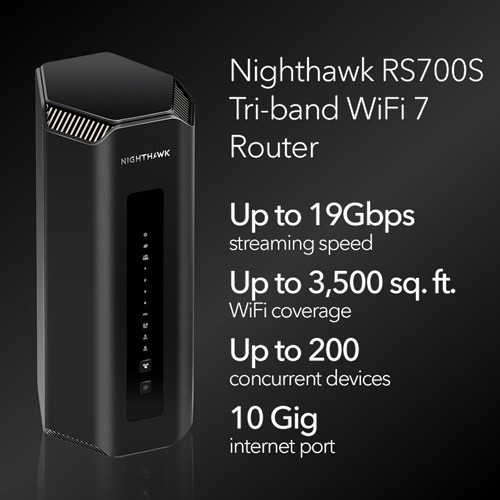
Wi-Fi 7 is the latest Wi-Fi Alliance standard for wireless networks and user devices. It’s a major leap in speed and connectivity, compared to previous Wi-Fi standards, such as Wi-Fi 6E and Wi-Fi 6. The latest Wi-Fi generation was officially launched at CES 2024 on January 8, 2024, with device certifications currently underway on a large scale.
This ultimate guide to Wi-Fi 7 lists the reasons this is such an important development and what all this means for you.
What Is Wi-Fi 7: Features and Benefits
Technically, Wi-Fi 7, or IEEE 802.11be, is the latest generation of Wi-Fi Alliance IEEE 802.11 standards that govern all the wireless network devices under the “Wi-Fi” brand. The number “7” indicates that we are currently in the seventh generation of Wi-Fi technology. Its main characteristics are:
- Ultra-high speed data transfer: the theoretical maximum speeds with Wi-Fi 7 have topped 40 Gbps, which is four times faster than the previous Wi-Fi 6E/Wi-Fi 6 generations.
- Using all three bands: Wi-Fi 7 taps into all three spectrum bands: 2.4 GHz, 5 GHz, and 6 GHz.
- Wi-Fi 7 CERTIFIED: with the launch of Wi-Fi 7, the Wi-Fi Alliance introduced the “Wi-Fi CERTIFIED 7” program to promote eligible devices to the latest Wi-Fi standard.

- 320 MHz channels: Wi-Fi 7 channels use 320 MHz channels, twice that of Wi-Fi 6E/Wi-Fi. This improves the throughput, i.e., the rate of data transfer.
- 16 spatial streams: Wi-Fi 7 has twice the spatial streams, compared to Wi-Fi 6, making it a much wider channel, to address the network congestion issues at crowded places.
- Multi-Link Operations (MLO): a marquee feature of Wi-Fi 7, MLO technology ensures that both the device and access point (AP) can use 2.4 GHz and 5 GHz bands simultaneously.
- 4096 quadrature amplitude modulation (QAM): QAM is a technical term used to measure the spectral efficiency of a network. Wi-Fi 7 is, at 4096-QAM, four times greater than Wi-Fi 6’s 1024-QAM. This translates to 20 percent higher spectral efficiency.
How Does Wi-Fi 7 Work?
The answer depends on your end use device. Wi-Fi 7 works like previous Wi-Fi standards and is backward compatible with Wi-Fi 6E/Wi-Fi 6, and Wi-Fi 5. If you have a Wi-Fi 7 compatible access point (AP), you don’t have to change your current laptop or smartphone, as they’ll connect on a single band just like before.
However, for Wi-Fi 7 to work to its full potential of maximum speed and throughput benefits, consider upgrading to a client device that is also Wi-Fi 7 certified, along with the Wi-Fi certified router. When both are Wi-Fi 7 certified, due to multi-link operations (MLO) technology, the client device can connect to the router on multiple bands.

Supposing your Wi-Fi 7 compatible laptop is at capacity on the 2.4 GHz band, it will automatically send a request to the router’s 5 GHz band, which means it gives your laptop more options to fund the downstream data packets.
In other words, if your Wi-Fi connection stops working for any reason, for the first time ever, your client device has the option to fall back to another network pipe. This leads to high availability and efficient Internet access.
Previously, Wi-Fi 6E and Wi-Fi 6 would only allow you to use one band. When both the client and router are going to use the same Wi-Fi 7 standard, it reduces the connection’s latency and improves the Wi-Fi network’s overall stability.
Is Wi-Fi 7 Available and Which Devices Support It?
Yes, the Wi-Fi 7 rollout has started already, but Wi-Fi 7 compatible devices are expensive.
For example, Netgear has announced its Nighthawk tri-band Wi-Fi router (RS700S) which provides speeds up to 19 Gbps. It works on 320 MHz channel and can scale to connect up to 200 devices simultaneously. At the moment, the router costs $700.

TP-Link also offers a tri-band Wi-Fi 7 router, Archer BE550 for $300, which provides speeds of 9.2 Gbps, 320 Mbps channel, and MLO. Apart from TP-Link, Asus and Linksys have also launched commercial Wi-Fi 7 routers.
In addition to routers, we have also seen the arrival of Wi-Fi 7 compatible Wi-Fi cards. For instance, there’s an Intel-certified Wi-Fi adapter for laptops and desktops: BE200NGW. It supports a 320 MHz channel, three bands of 2.4, 5 and 6 Ghz, and a data transfer speed of 9.3 Gbps. Insert it into any Intel laptop with compatible Wi-Fi modules.

Some chipmakers and devices were already claiming to be Wi-Fi 7 compatible before the official announcement of Wi-Fi 7 CERTIFIED by Wi-Fi Alliance. Currently, they are all pending the official Wi-Fi CERTIFIED 7 endorsement.
As Wi-Fi is the most trusted computer networking standard in the world, device-makers will line up to migrate their equipment to Wi-Fi 7. In 2024 alone, the Wi-Fi Alliance expects over 233 million Wi-Fi 7 certified smartphones, tablets, PCs, and routers to enter the market.
Should You Upgrade to Wi-Fi 7?
If you’re building a smart home, Wi-Fi 7 will someday form the backbone of all connections in devices. Currently, the biggest challenge is that very few devices are compatible with the new wireless standard.
Also, not all the claimed features are available on all devices. From a client perspective, there aren’t enough smartphones and laptops with Wi-Fi 7 capabilities, although you can use a Wi-Fi 7 adapter with Intel laptops.
In our view, you should wait a few months more, until at least July 2024, for the Wi-Fi 7 router prices to hopefully drop, and many more certified client devices to enter the market. A safer bet would be upgrading to Wi-Fi 7 by the end of the year.
Are you facing slow Wi-Fi connections in your home? There are ways to fix it. With the onset of Wi-Fi 7 certified smartphones, you will be able to use your phone as a Wi-Fi hotspot.
Featured image credit: Pixabay
Our latest tutorials delivered straight to your inbox